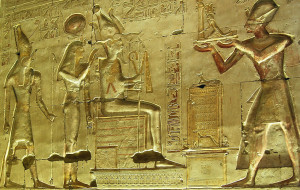Abydos, the burial site of pharaohs as early as 3,000 B.C., later became associated with Osiris, a legendary pharaoh considered god of the afterlife. Popular stories told how Osiris had been killed and then miraculously fathered the falcon-faced god Horus with his sister/wife Isis. Pharaohs saw themselves as earthly manifestations of Horus and aspired to live on like Osiris after their deaths.
In about 1280 B.C., Pharaoh Seti I built a temple on the west bank of the Nile at Abydos to honor himself and the triad of Osiris, Isis and Horus. Reliefs show Seti I and the gods, with Osiris depicted with a curved beard reflecting his death, Isis crowned with the sun disk, and Horus shown holding a cross-shaped ankh. Seti’s son Ramses II, often considered the pharaoh of the Exodus, expanded the temple, showing himself with the Abydos triad in similar, but less well-executed, scenes. The well-preserved temple walls also contain a unique list of earlier pharaohs, minus the female Hatshepsut and the short-lived Tutankhamen.
When the Greeks conquered Egypt, they took home from Abydos images and stories of Osiris, Isis and Horus. Isis became popular throughout the Greek and later Roman world as the “Queen of Heaven” and “Mother of God.” The Roman Catholic Church later adopted these titles for Mary, the mother of Jesus. Artists depicted Mary as Isis, with an Egyptian-style sun crown. Early paintings of Mary with Jesus on her lap mimicked temple scenes of Isis nurturing Horus. As a result of these titles and images, Muhammad mistakenly concluded that the Christian Trinity consists of God, Mary and Jesus, which he repudiated as a pagan idea. The Quran also denounces any trinity including Mary.
The carvings in the temple of Seti I, the finest remaining examples of Egyptian bas relief, are reason enough to visit Abydos. Seeing the bases for reconstructing the order of pharaohs and for confusion over the Holy Trinity is a bonus.

Comments are closed.